(PCC) Program on Chinese Cities – Thoughts on Overseas Travels Series
Authors: Huanhuan Qiang,
School of Architecture, Southeast University, joint PhD student with UNC, focusing on the living spaces of vulnerable groups. Email: seuqhh@hotmail.com
As winter gives way to spring, I find myself having spent the winter at the University of North Carolina at Chapel Hill (UNC), welcoming a spring blooming with flowers. It was my first arrival in the United States, and settling in North Carolina (NC), located on the southeastern coast near the Atlantic and very suitable for living, I guess I’ve contributed a bit to the region with the highest concentration of PhDs in the country. To me, this is a new starting point, with the UNC campus holding my life. But let’s cut to the chase and sort things out.
In the academically rich NC, UNC in Chapel Hill, Duke hidden in Durham, and NC State University encircling Raleigh stand strong, echoing the famous “Research Triangle” in human geography. These institutions provide significant academic and intellectual support behind the scenes for the Triangle area, while the Raleigh-Durham International Airport (RDU) is strategically placed at the Triangle’s center, offering quicker transportation and more convenient connections (Image 1).


1. University of North Carolina at Chapel Hill
UNC, as one of the original eight “public Ivies,” has upheld the motto “Lux, Libertas” (Light, Liberty) since its founding in 1798, with a campus environment that is quite comfortable and pleasant. The campus layout extends along a north-south axis, with Battle Park, major sports fields, and Coker Pinetum to the east, forming a perfect landscape barrier for the campus; on the other hand, Route 501 and Fordham Blvd to the south connect Durham and surrounding areas, while Manning Dr to the south, South Rd in the middle, E Franklin St to the north, and Columbia St to the west make up the main campus road network. In terms of architecture, starting from the oldest houses near Franklin Street, each era has left valuable legacies. UNC’s expansive and beautiful campus is broadly divided into north, central, and south parts, where the McCorkle Place, featuring the iconic neoclassical rotunda, has become a pilgrimage site for students (Image 3), and the Old Well within it carries symbolic significance and legendary color; Polk Place is named after North Carolinian and UNC alumnus President James Knox Polk. The Morehead-Patterson Bell Tower, donated by these two alumni, chimes on the hour, filling the campus with an ivory tower aura (Image 4). The axis extends southward to Kenan Memorial Stadium, concluding public activities in a single stroke, blending classical tradition with a modern, flexible atmosphere (Image 5).
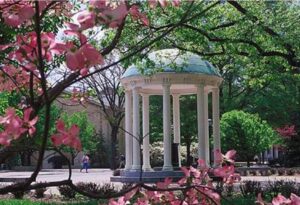
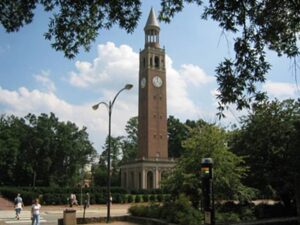
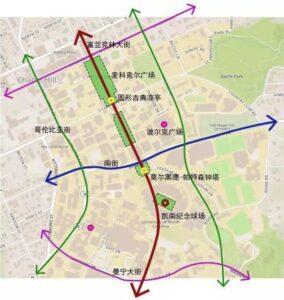
UNC’s libraries are my favorite places. Libraries can be considered the heart of a university, and UNC offers many opportunities for us to share this heart. Davis Library, Health Sciences Library, Wilson Library, and others are excellent places for study. My favorite is Davis Library, where public spaces and reading environments complement each other, and the arrangement of the bookshelves harmonizes with the building’s structural order. The borrowing space and meditation platforms are set on either side, with meticulously designed building materials and window openings, combining framed views without losing construction logic, offering multiple views from a single window and unique spatial experiences at every turn (Image 6).
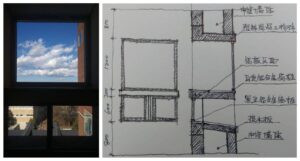
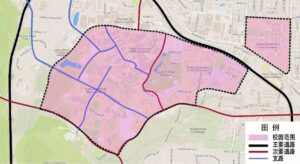
2. Duke University
Duke University, also in the Research Triangle, presents a different overall campus appearance and character from UNC due to its private and family-oriented nature. Located in Durham and initially designed by architect Julian Abele, the campus planning is based on a traditional classical cross-axis (Image 8), with buildings symmetrically arranged around the main planning structure and combined with the classically naturalistic gardens to the east, creating an elegant and meaningful campus character. Unlike UNC’s warm red brick tone, Duke primarily uses natural stone as its building material, creating a “Gothic paradise” in Georgian style. The campus buildings are classic and exquisite, all made of granite, yet no two are exactly alike. The environment is beautiful, and the climate warm and comfortable, lending Duke University a gentlemanly demeanor.
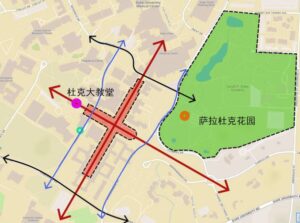
The campus centers around the cross-axis, combined with the French classical garden in the northeast corner, creating an exceptionally pleasant and comfortable campus environment within the strict Gothic layout. Buildings integrate with courtyard designs, offering different academic atmospheres and life essences in each courtyard; the terrain rising from southwest to northeast along the axis enhances the depth of the axis, with a stronger sense of ceremony. After passing through the first arch at the southern end of the axis (Image 9), one does not pass through the first courtyard along the center of the axis but enters the main courtyard through the second arch from either side, with plants planted at the entrance of the second arch blocking the view, revealing the full extent of the north-south axis only after bypassing them (Image 10). This technique of delayed gratification, abundant in Chinese classical gardens, is surprisingly found in Duke’s application.
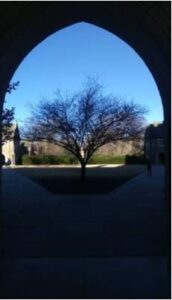
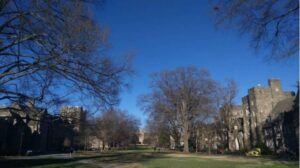
The most eye-catching feature is the Duke Chapel at the core, with a Gothic exterior hiding a shockingly sacred interior environment. The chapel’s sound system is among the best in the United States, making one feel devout upon entering (Image 11).
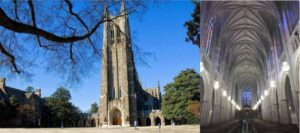
Additionally, it’s worth mentioning Duke’s gentle and respectful approach to campus renewal and transformation. In the renovation of the student center, architect Grimshaw added a glass box on the basis of the original classical architecture (http://www.archcollege.com/archcollege/2016/12/30271.html). “This newly built grid structure connected to the building enlivens pedestrian flow and frequent interactions between buildings, fostering a vibrant, rejuvenated student community,” Grimshaw said. The architecture, supported by two giant shuttle-shaped steel columns holding a two-story high glass hall, creates a modern indoor environment and atmosphere, contrasting with the original building in a dynamic and static comparison, reflecting the characteristics of temporal and spatial renewal and transformation (Image 12).
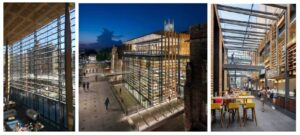
3. Conclusion
Although UNC and Duke both utilize axes, regions, and nodes to organize the overall campus structure, due to differences in founding periods, site conditions, and creators’ circumstances, each school displays unique planning and architectural characteristics: UNC unfolds along a north-south axis, with multiple squares along the axis, a modest classical rotunda as the spiritual center, combined with bell towers, sports fields, and free pathways to control the overall campus appearance; Duke is more flexible, adding horizontal secondary axes to the longitudinal main axis, connecting open green spaces with towering Gothic chapels as the spiritual core, and controlling the overall campus character with courtyard space nodes and specific pathways. Both schools, one open and free, the other refined and delicate, showcase their own temperaments through campus planning, offering experiences worth cherishing for a lifetime with the changing seasons.
